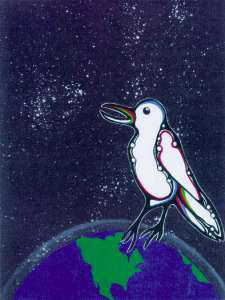
Artist: Tammy Alexander
Rekindling Traditions
Cross-Cultural Science & Technology Units (CCSTU)
For Northern Saskatchewan Schools

Artist: Tammy Alexander
Background
Aboriginal student participation in science and engineering is very low in Saskatchewan. Among the many reasons proposed to explain this fact, Aboriginal educators emphatically point to the vast cultural difference between Aboriginal worldviews of many students and the Western science worldview expressed in science courses. Without instruction meaningfully set in the context of the local community, many students (Aboriginal and non-Aboriginal) find the science curriculum culturally foreign and inaccessible. Culturally sensitive approaches to teaching will treat science instruction as a cross-cultural event. There is a great diversity in cultures from community to community across the north. Thus, culturally sensitive instruction will vary from community to community.
The project focuses mainly on integrating Aboriginal science and
technology with the provincial science curriculum (seven dimensions of scientific
literacy). As the project expands in the future, science will be integrated
with other subjects, much more than it will be in this preliminary project.
Objectives
Our work is guided by Elders (principally Henry Sanderson, La Ronge) to ensure that appropriate protocols are followed and that Aboriginal culture is respected and properly protected.
This preliminary project only begins to explore cross-culture science instruction. Our research and development (R&D) team is comprised of six teachers from Provincial schools, backed by a resource infrastructure to help us with immediate and unpredictable needs. Once our team has confidence in our cross-cultural teaching materials and the processes for producing those materials, then the time will be appropriate to share what we have (summer of 2000). One way to expand upon this project in the future would be to seek further funding to support the participation of Band schools. But first, the project must have something worthwhile to offer other schools.
Overview of the Project ( 2 year duration)
During a series of working meetings, the R&D team produced ideas which individual teachers took back to their schools and worked on with the help of Local Advisory People ó Elders and other key people in the community. During additional meetings, the R&D team developed the materials further. Between these meetings, the team facilitator (Glen Aikenhead, University of Saskatchewan) was in contact with the teachers in their communities. Six teaching units are being produced and piloted:
These communities are culturally different. Therefore when a unit is introduced into a different community, Local Advisory People need to help the teacher modify the unit so it is responsive to the local culture and environment. Because the piloting process is a principal outcome to our CCSTU project, special attention is given to this process. Case studies of the process will be written so that others can read our stories and be guided by what we did.
At the end of the piloting process, the packages of teaching units will be polished further and then made available to any school. The R&D team will conduct workshops for other teachers.
Throughout this two-year CCSTU project, time is taken to ensure proper protocol, a respect for Aboriginal knowledge, and a high quality teaching unit.
Products
The CCSTU project has produced:
Partnerships & Funding
A joint partnership was established among Northern Lights School Division, Île-à-la-Crosse School Division, Saskatchewan Education (Northern Division), and the College of Education (University of Saskatchewan). The CCSTU project was funded by the Cameco Access Program for Engineering and Science (CAPES), the Stirling McDowell Foundation, and by the participating partners.
[ Main Menu ]